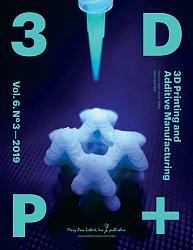Three-dimensional (3D) printing of biomaterials has the potential to become an ecologically advantageous alternative compared with conventional manufacturing based on oil-derived polymer materials. In this study, a novel 3D printing technology is applied that combines ultraviolet (UV) curing with paste extrusion. This hybrid manufacturing technique enables the fabrication of complex geometries from high filler-ratio pastes. The developed biocomposite aims for suitable mechanical properties in terms of tensile and compressive strength. It is composed of acrylic acid, cellulose acetate, α-cellulose, and fumed silica with a cellulose ratio of more than 25 vol-%. The material is extruded with an in-house-developed 3D printer equipped with a 12 W UV light curing source, which enables concurrent curing and extrusion. Two different UV-curing strategies were tested: postcuring without concurrent curing and postcuring with concurrent curing. The total UV-curing duration was kept constant with all samples. Tensile testing in accordance with ASTM standard D638-14 Type 4, compression testing according to ASTM D695-15, and overhang tests were conducted. As a result, samples without notable shrinkage, suitable tensile strength (up to 17.72 MPa), competitive compression testing parameters (up to 19.73 MPa), and an enhanced overhang angle (increase of more than 25°) were produced, leading to new applications and more freedom in design due to higher possible unsupported overhangs when using UV-curing during the print. Overall, constant UV light radiation during the print leads to improved mechanical properties due to the possibility of bypassing the UV-penetration depth constraint. It should be considered when extruding photopolymer-based composites, especially for large and complex components with a low degree of translucency.
For more information, visit here:
https://www.appropedia.org/Mechanica..._Biocomposites
View the paper here:
https://www.academia.edu/39160225/Me..._Biocomposites



 LinkBack URL
LinkBack URL About LinkBacks
About LinkBacks



 Reply With Quote
Reply With Quote
Bookmarks